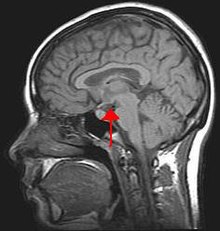User:Dylanarthaud/sandbox
Aphagia is the complete inability or refusal to swallow. The word is derived from the Ancient Greek prefix α, meaning "not" or "without," and the suffix φαγία, derived from the verb φαγεῖν, meaning "to eat." It is related to dysphagia which is difficulty swallowing (Greek prefix δυσ, dys, meaning difficult, or defective), and odynophagia, painful swallowing (from ὀδύνη, odyn(o), meaning "pain").[1] Aphagia may be temporary or long-term, depending on the effected organ. It is an extreme, life-threatening case of dysphagia. Depending on the cause, untreated dysphagia may develop into aphagia.
Classification
[edit]Behavioral Aphagia
[edit]
The following behavioral classifications result from studies done on rats, in which lesions were made on the lateral hypothalamus region in the brain.
- Passive aphagia: An animal with passive aphagia will not respond to food if it is presented. However, if food is inserted into the mouth, the animal will chew.
- Active aphagia: Active aphagia is a complete rejection of food. The animal will physically push food away or move its head from it. One might first sample the food by smelling or tasting, then spit out anything in the mouth. Afterwards the animal will show a complete repulsion to the food. The animal reacts to food as if it is bitter or foul.
- Mixed aphagia: When presented with food, the animal initially does not react positively or negatively. However, when food is placed in the mouth, the animal demonstrates active aphagia, spitting out the food and refusing to eat thereafter.[2]
These studies point to the function of the hypothalamus in regulating food intake. Animals in this study also demonstrated several other types of eating behavior: "weak eating," in which the animal slowly approaches, chews, and swallows small observable amounts of food for a brief period; "good eating," in which the animal reaches normally for the food and eats reliably; and "vigorous eating," in which the animal gluttonously reaches for and devours the food. In these cases, there was either minor or no damage to the lateral hypothalamus.[2]
Aphagia not classified under behavioral aphagia typically has a structural cause, see causes.
References
[edit]- ^ List of medical roots, suffixes and prefixes. (n.d.). In Wikipedia. Retrieved November 10, 2013, from http://en.wikipedia.org/wiki/List_of_medical_roots,_suffixes_and_prefixes.
- ^ a b Schallert T, Whishaw I. Two types of aphagia and two types of sensorimotor impairment after lateral hypothalamic lesions: Observations in normal weight, dieted, and fattened rats. Journal Of Comparative And Physiological Psychology [serial online]. August 1978;92(4):720-741. Available from: PsycARTICLES, Ipswich, MA. Accessed November 12, 2013.

